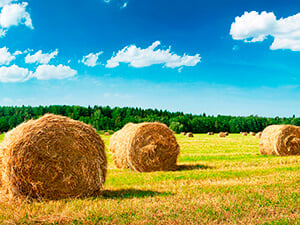Wagner Meters Moisture Meters for Hay
What is a Hay Moisture Meter?
A Hay moisture meter is a precision instrument that uses the principle of electrical resistance to determine moisture content in different types of hay.
Why should I use a Delmhorst Hay Moisture Tester?
Moisture content is one of the most important variables — and challenges — the high quality hay producer must face. Baling at proper Moisture levels is critical to the hay grower’s objective — to bale and store hay in a manner to reduce mold development and at the same time preserve leaves, color, and feed value. Using a Delmhorst Hay Moisture Tester is the best way a farmer can be sure that his hay is being baled at the ideal Moisture levels.
How does a Delmhorst Moisture Meter operate?
Delmhorst probe-type meters operate on the principle of electrical resistance, utilizing the relationship between the Moisture content of the material and its conductivity. This relation is possible because Moisture is an effective conductor of electricity and hay acts as an effective insulator. The "reading" is made between the two metal contacts at the tip of the probe.
How do Delmhorst Hay Moisture Meters Work?
Delmhorst Hay moisture meters use the principle of electrical resistance to determine moisture content in different types of hay. Because moisture conducts electricity and dry hay acts as an insulator, wet hay will let electricity through easier than dry hay, resulting in a higher reading.
When a hay moisture meter probe is inserted into hay, the hay acts as an element in an electrical circuit, reading the resistance between two points in the hay prod. The amount of resistance to this current (measured in Ohms) is used by the meter to measure how much moisture is present in the hay.
At what Moisture range can Hay be baled?
Traditionally, the recommended Moisture content for baling hay without a preservative is between 18-20%.If using a preservative, follow the instructions set forth by each particular preservative manufacturer. Smart use of a Moisture Tester in combination with preservatives and drying agents allows hay to be baled at higher than traditionally recommended Moisture levels.In either case, do not attempt to bale hay before it is at an acceptable Moisture level, even when using a preservative.
What methods are commonly used for testing Hay Moisture?
In The Windrow:
Collect hay from the windrow and place it in a five or ten gallon container. Apply a multi-pin prod to the hay and press down on the handle. Take a reading. Mix the hay and repeat this procedure no less than three times.
Then from the same area of the windrow, select up to five large, slower-drying stems and place one at a time across two adjacent points on the multi-pin prod and take readings. The average of these stem readings should be about two to five points higher than actual Moisture content.
Repeat these steps in different parts of the field and pay special attention to the areas where the hay is heaviest. Your decision to start baling should consider the amount of variation found among windrow readings as well as the average stem Moisture.
What affects the meter readings?
Besides Moisture content, factors which affect meter readings most are: Moisture distribution, crop variety, temperature of the hay, crop maturity, sample density, cutting, and the overall climatic conditions present. Cloud cover and high relative humidity result in more variable Moisture readings than a sunny, dry day with light breezes.
How can i know i'm receiving the most accurate results?
Because field conditions can change rapidly, accuracy guidelines must be considered in terms of "ranges", not specific points. Claims of accuracy should be taken with caution, because it is unlikely that such claims can be consistent. Expert evaluations of the same meter may yield different results, mainly dependent on the technician’s sampling procedure, conditioning and uniformity of the samples, difference in crop, and differences in oven test procedure. For optimum results, carefully read the owners manual provided with each meter.
Is there a way to make sure my Delmhorst meter is in calibration?
The primary or electrical calibration of the Delmhorst tester can easily be checked by the built-in calibration checkpoint feature or by using an optional Moisture content standard.
How do I keep a Delmhorst meter in good working condition?
Delmhorst Moisture Meters are well known for their ruggedness and ability to withstand years of rough handling. Like any testing instrument, a little care goes a long way toward trouble-free service:
Store the meter in clean, dry place
Change batteries and pins as needed
Keep the meter and electrode clean by using any biodegradable cleanser sparingly on external parts only.
How Wet or Dry Should My Hay Be?
The answer to this depends on a few things:
- Are you preparing to harvest or to bale the hay?
- What kind of baler are you using (large square, small square, round)?
- How will your hay be stored?
Balers that compact hay tightly, such as the large square and round balers, tend to require drier hay, while balers that don’t compress hay so much can usually take a bit more moisture.
The exact amount may vary, but recommendations from some organizations, such as Alberta Agriculture and Forestry, put safe baling moisture ranges for a dense, 1800-lb. bale at 12-16% moisture content, and small, 60-lb. bales at 18-20% moisture content.
Outside of these %MC ranges, farmers risk either compromising the nutritional value of their hay, or even risking spontaneous combustion.






